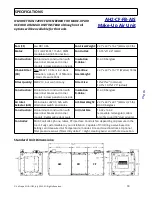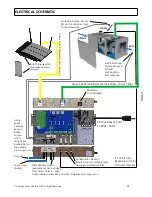
surface area of its opening minus the surface area of any grilles, louvers, or screening covering it. Different
types of vents have different ratios of net free area to total area.
Manufacturers typically publish their vents net free ventilation areas and/or ratios in their products
specification documents.
If this information is unavailable,
a ratio of 50% net free area to total area is
usually a good rule of thumb
. The most notable exception to this rule of thumb are ridge vents. The
industry standard net free ventilation area for ridge vents is 13% of the vent’s length in feet. Thus, a ten
foot ridge vent would provide 1.3 sq. ft. of net free ventilation area.
While in our experience most properly constructed homes have adequately ventilated attics, not all do.
Because sufficient ventilation is so critical to this fan’s performance, it is important that the home’s
existing ventilation be verified before it is installed.
Since most attics have multiple vents, often of different types, it is necessary to count each vent, noting
its type and size. Apply the appropriate ratio to the dimensions of each vent to find its net free area, and
sum these values to find the attic’s total ventilation. An example of how these calculations are made is
given in the chart below.
Vent Type Dimensions Total Area (sq/ft)
Net Free Area
Ratio (NFA)
Net Free Ventilation Area
(= Total Area x NFA
24” x24”
24” x 24”
÷
144 = 4 ft
2
50%
4 ft
2
x 0.50 = 0.89 ft
2
Ridge
10 feet
n/a
13%
10 feet x 0.13 = 1.33 ft
2
Round
10” diameter 3.14 x 5” x 5”
÷
144 = 0.55 ft
2
50%
0.55 ft
2
x 0.50 = 0.28 ft2
Total Net Free Ventilation Area
1.57 ft
2
START-UP AND OPERATION
Note to the user:
The Airscape Make-Up Air unit is designed to be used with a well sealed building. The
fan controller is dependent on a measurement of pressure within the building that is readily influenced by
any depressurization sources, as well as the introduction of make-up air into the building. A building that is
not well-sealed has a lessened response to pressure influences. As such, a Make-Up Air unit that is
installed in a building that is not well sealed, or operated in a building that has openings to the outside
such as windows or doors, will have a lessened response to depressurization sources, and may even
operate improperly. Many homes have small constant-demand depressurization appliances, such as
bathroom fans. If such devices are present, the unit may constantly run, as it detects the slight
depressurization caused by these appliances. If this behavior is unwanted, configuration of the unit during
installation may be needed.
Make Up Air Unit Calibration
Close all windows, doors, and other commonly-used ventilation openings in the home. Turn off all
appliances that cause intermittent depressurization, such as kitchen hoods and user controlled bathroom
fans. If there are constant-demand depressurization appliances present, leave them on.
Connect to the Make-Up Air interface using a web-enabled device. On the Controls tab in the interface,
make note of the Building Pressure within the home. This is the ambient home pressure.
© AirScape MUA-IOM, July 2022, All Rights Reserved.
27





























